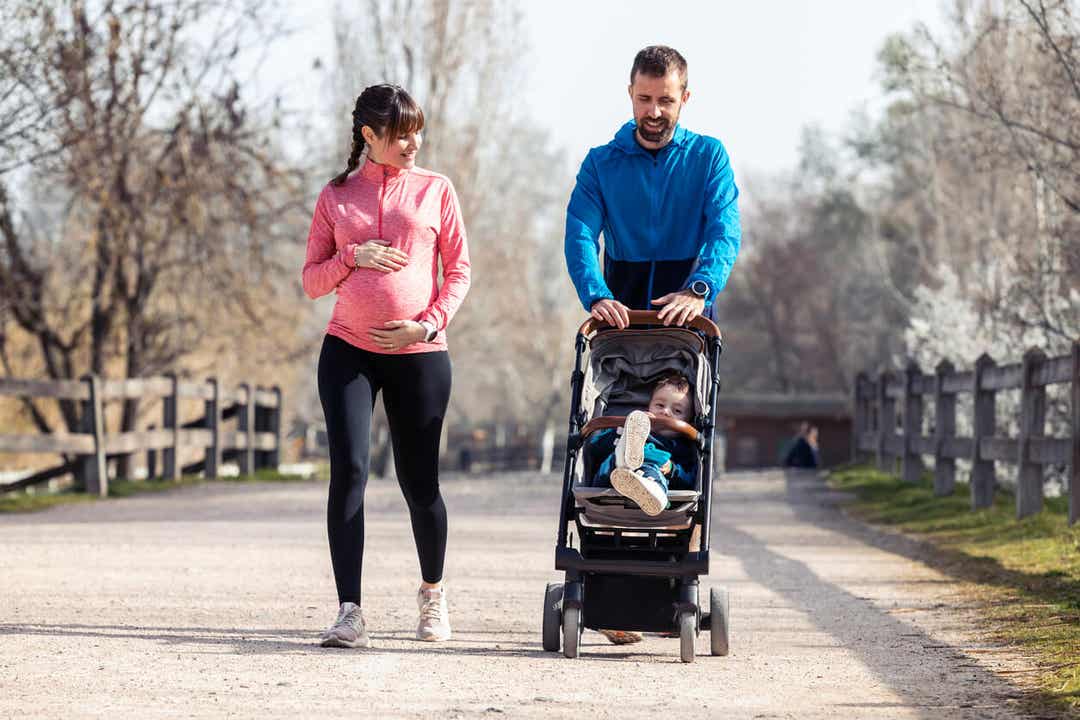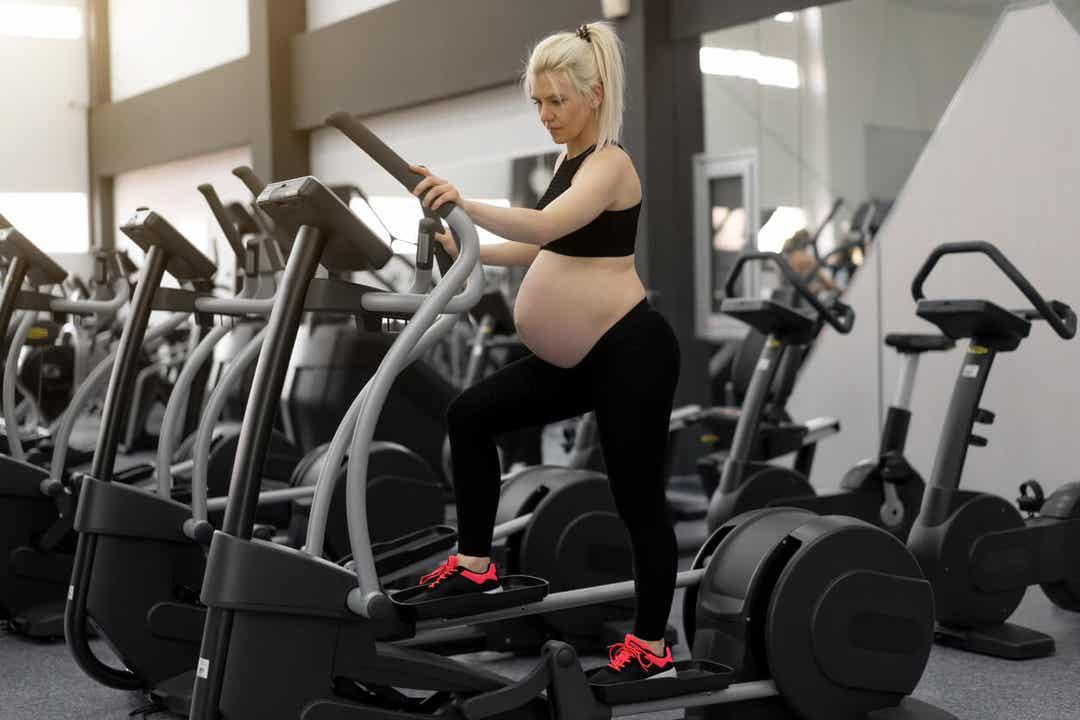What Kind of Exercise Can You Do If You're Pregnant?

Exercising has many benefits throughout all stages of life, as long as it’s done taking into account the conditions of each moment. And exercise is no less important during pregnancy. What kind of exercise can you do if you’re pregnant? That fact is, there are many types of exercise that you can do if you’re pregnant. Of course, as long as your doctor doesn’t say otherwise.
So, in the case of exercise during pregnancy, it’s important to keep in mind that the benefits aren’t only for the mother. There for the baby as well! What’s more, the benefits are short, medium, and long term.
Exercise during pregnancy
According to the second edition of the CDC’s physical activity guidelines, pregnant women should get at least 150 minutes of moderate-intensity aerobic physical activity per week, preferably spread throughout the week. In addition, women who already engage in high-intensity aerobic physical activity can continue to do so during and after pregnancy.
However, we mustn’t lose sight of the fact that all this must be supervised by a doctor, as there are at-risk situations that require a certain degree of rest or in which exercise is completely inadvisable.

What kind of exercise can I do if I’m pregnant?
Keep in mind that many types of exercise are possible if you’re pregnant. A good way to know what type of exercise or sport you should avoid is to apply a simple rule: Pregnant women should avoid any physical activity that carries a risk of falls, blows, collisions, or impacts. Furthermore, in the vast majority of cases, the doctor will recommend avoiding exercises that involve impact (except in some cases and under certain circumstances).
Without losing sight of this, here are the most recommended types of exercise you can do if you’re pregnant.
Swimming, the best exercise you can do if you’re pregnant
Swimming’s usually a very beneficial type of training to do during pregnancy. This is because you weigh less in the water, so you’ll feel lighter and more agile. In addition, the temperature of the water helps to reduce swelling in the legs and to activate circulation.
In any case, you should practice precautions, both in and out of the pool. For example, it’s important to always swim with a support to hold on to in case of need (the pool wall or a corkboard). You also need to know that there’s a lifeguard who is attentive. Out of the water, be careful not to slip, both around the pool and in the changing rooms.
If you have not swum before, it is advisable to look for a swimming or aquatic exercise group for pregnant women or, if necessary, a group led by a professional with the necessary skills to make the necessary adaptations at each stage of pregnancy.
Walking
Walking’s one of the exercises that women should do on a daily basis during pregnancy. In fact, unless the doctor indicates rest, you can walk until the last day before your child’s born.
At this point, we need to point out that it’s preferable to walk in the street or in the countryside, rather than on a treadmill, especially as the pregnancy progresses. This is because walking on a treadmill carries certain risks that aren’t present walking outdoors. It’s possible to walk on a treadmill, but without losing sight of the problems that may arise in the event of accidental acceleration or loss of balance.
Elliptical
A much safer option for pregnant women who want to do indoor aerobic exercise is the elliptical trainer. The difference is that the elliptical doesn’t move on its own, while the treadmill does. In addition, it has the advantage of also working the upper body while providing grip support.

In any case, you have to be very careful getting on and off the machine. So don’t hesitate to ask for help, especially when you notice the size of your belly starting to look big. And if you can’t see your feet when you look down, don’t hesitate for a moment.
Yoga
Yoga’s another type of exercise that will come in handy during pregnancy, but with modifications, especially if you’ve never practiced it before. There are prenatal yoga programs adapted to each stage of pregnancy. They focus on encouraging stretching, mental focus, and concentrated breathing.
In any case, keep in mind that certain balancing positions may pose a significant risk. Even if you did them before, be aware that your center of gravity changes along with your body as you age.
Exercising has many benefits throughout all stages of life, as long as it’s done taking into account the conditions of each moment. And exercise is no less important during pregnancy. What kind of exercise can you do if you’re pregnant? That fact is, there are many types of exercise that you can do if you’re pregnant. Of course, as long as your doctor doesn’t say otherwise.
So, in the case of exercise during pregnancy, it’s important to keep in mind that the benefits aren’t only for the mother. There for the baby as well! What’s more, the benefits are short, medium, and long term.
Exercise during pregnancy
According to the second edition of the CDC’s physical activity guidelines, pregnant women should get at least 150 minutes of moderate-intensity aerobic physical activity per week, preferably spread throughout the week. In addition, women who already engage in high-intensity aerobic physical activity can continue to do so during and after pregnancy.
However, we mustn’t lose sight of the fact that all this must be supervised by a doctor, as there are at-risk situations that require a certain degree of rest or in which exercise is completely inadvisable.

What kind of exercise can I do if I’m pregnant?
Keep in mind that many types of exercise are possible if you’re pregnant. A good way to know what type of exercise or sport you should avoid is to apply a simple rule: Pregnant women should avoid any physical activity that carries a risk of falls, blows, collisions, or impacts. Furthermore, in the vast majority of cases, the doctor will recommend avoiding exercises that involve impact (except in some cases and under certain circumstances).
Without losing sight of this, here are the most recommended types of exercise you can do if you’re pregnant.
Swimming, the best exercise you can do if you’re pregnant
Swimming’s usually a very beneficial type of training to do during pregnancy. This is because you weigh less in the water, so you’ll feel lighter and more agile. In addition, the temperature of the water helps to reduce swelling in the legs and to activate circulation.
In any case, you should practice precautions, both in and out of the pool. For example, it’s important to always swim with a support to hold on to in case of need (the pool wall or a corkboard). You also need to know that there’s a lifeguard who is attentive. Out of the water, be careful not to slip, both around the pool and in the changing rooms.
If you have not swum before, it is advisable to look for a swimming or aquatic exercise group for pregnant women or, if necessary, a group led by a professional with the necessary skills to make the necessary adaptations at each stage of pregnancy.
Walking
Walking’s one of the exercises that women should do on a daily basis during pregnancy. In fact, unless the doctor indicates rest, you can walk until the last day before your child’s born.
At this point, we need to point out that it’s preferable to walk in the street or in the countryside, rather than on a treadmill, especially as the pregnancy progresses. This is because walking on a treadmill carries certain risks that aren’t present walking outdoors. It’s possible to walk on a treadmill, but without losing sight of the problems that may arise in the event of accidental acceleration or loss of balance.
Elliptical
A much safer option for pregnant women who want to do indoor aerobic exercise is the elliptical trainer. The difference is that the elliptical doesn’t move on its own, while the treadmill does. In addition, it has the advantage of also working the upper body while providing grip support.

In any case, you have to be very careful getting on and off the machine. So don’t hesitate to ask for help, especially when you notice the size of your belly starting to look big. And if you can’t see your feet when you look down, don’t hesitate for a moment.
Yoga
Yoga’s another type of exercise that will come in handy during pregnancy, but with modifications, especially if you’ve never practiced it before. There are prenatal yoga programs adapted to each stage of pregnancy. They focus on encouraging stretching, mental focus, and concentrated breathing.
In any case, keep in mind that certain balancing positions may pose a significant risk. Even if you did them before, be aware that your center of gravity changes along with your body as you age.
All cited sources were thoroughly reviewed by our team to ensure their quality, reliability, currency, and validity. The bibliography of this article was considered reliable and of academic or scientific accuracy.
- González-Collado, F., Ruiz-Giménez, A., & Salinas-Salinas, G. J. (2013). Indicaciones y contraindicaciones del ejercicio físico en la mujer embarazada. Clínica e investigación en ginecología y obstetricia, 40(2), 72-76. https://www.elsevier.es/es-revista-clinica-e-investigacion-ginecologia-obstetricia-7-articulo-indicaciones-contraindicaciones-del-ejercicio-fisico-S0210573X11001444
- CDC. (n.d.). Healthy Pregnant or Pospartum Women | Physical Activity. Centers for Disease Control and Prevention. https://www.cdc.gov/physicalactivity/basics/pregnancy/index.htm
This text is provided for informational purposes only and does not replace consultation with a professional. If in doubt, consult your specialist.








